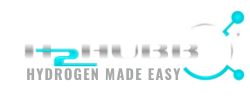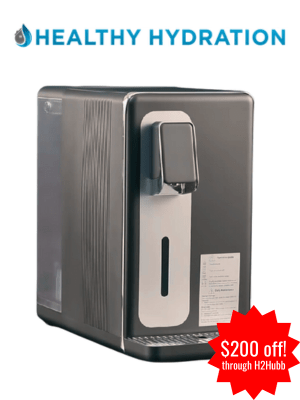Hydrogen water is growing in popularity around the world and in the US, due to its promising medical research [1] and many companies and/or proponents touting it’s potential health benefits. This has led to many people wanting to try hydrogen water and considering how to do so in the most cost-effective manner possible. I have been approached many times over with the question “How to make hydrogen water?” or “How does one make hydrogen water at home, the cheap way”.
In fact, this DIY hydrogen water video has over 124,000 views on YouTube and would likely be even more if YouTube didn’t adjust their algorithm.
These questions and video only reveal that my previous statement holds merit and DIY (Do It Yourself) methods for hydrogen water is an approach many individuals are considering. In this article, we are going to cover some of the most common or popular DIY methods for producing hydrogen water at home and several interesting pitfalls these methods may hold.
First, for those who don’t know, hydrogen water or hydrogen-rich water is ordinary water with molecular hydrogen (hydrogen gas) dissolved into the water. If you want to learn more about hydrogen water read my “What Is Hydrogen Water” article. Well, considering that my explanation appears rather simple, it would lead to the notion that producing this type of water at home is simple, and sure some methods are, but the real question is not “How to make hydrogen water at home? “ but “How do you make hydrogen water at home safely and with a therapeutic concentration of molecular hydrogen?”. We will explore this question further in the article.
If you’re new to hydrogen therapy, explore the transformative benefits it offers! Explore the video below to learn why hydrogen water and inhalation are essential for everyone worldwide. Don’t miss out on the key to a healthier life!
Here are the most common DIY methods for producing hydrogen-rich water:
- Magnesium Sticks
- Homemade Water Electrolyzers
- Hydrogen Gas Tanks
Through these methods, many individuals attempt to produce this therapeutic form of water at home. However, what they might not know are the potential challenges that await them. At H2HUBB, we want to do the hard work so you don’t have to. Thus I will address briefly several safety concerns with each method as well their therapeutic value in comparison with the research and other related hydrogen products.

Magnesium Sticks
Magnesium sticks, also known as Mg-rods, are one of the cheapest ways if not the cheapest way to produce H2 water. This method is a legitimate way to produce hydrogen-rich water and has been used in some research studies [2]. These sticks consist of pure metallic or elemental magnesium (99%) and react with water to produce molecular hydrogen (Mg + 2H2O => Mg(OH)2 + H2)[3]. They normally require a catalyst, such as malic acid to stimulate the reaction and/or prevent passivation. If an individual uses malic acid then the reaction will also produce magnesium malate (C4H4MgO5) as a by-product. This method is marketed to produce 1.0~1.5 mg/L (ppm) of dissolved molecular hydrogen in 500 mL of water[4]. The cost of these sticks ranges from $50~$150 USD for one or two 6-inch sticks, which can last up to 4~6 months. That means one stick might be able to produce 48 gallons of hydrogen water if a person were to drink 1 liter of H2 water per day. That sounds great, right?
Well, unfortunately, it’s not all pluses for this method of producing hydrogen water. There are many aspects involved in magnesium sticks that most are not aware of, one being the purity of the Mg-rods. Many companies claim 99% or greater for the purity of their Mg-rods or sticks, however, you should always confirm the purity with the company before purchasing. Impurities in the Mg-rods can produce hydrogen water that is not suitable for human consumption. It’s important to always ask these companies if they have laboratory analysis for their Mg-rod in terms of Mg-rod purity and safety of the drinking water it produces. If they can not confirm the purity of their Mg-rods or the safety of the water it produces then that is a red flag about the company, which may mean you may have to get your own water quality report on the Mg-sticks which can cost an additional $75~$150 USD.
Furthermore, when producing hydrogen water in this way (Mg rods), it is difficult to control several important variables such as the release of Mg into the water, controlling the pH of the water, and the by-products that are produced (depending on your catalyst), etc. Individuals can easily overdose on Mg or induce magnesium toxicity (hypermagnesemia) without realizing it with this method, especially if they have compromised kidneys and renal failure. It can be very dangerous if you have kidney issues. In healthy individuals, the kidneys will eliminate the excess Mg in the urine, which is good [4]. However, it’s not necessarily wise to chronically surpass the RDA for Magnesium which, for healthy men, is 400~420 mg, and for healthy women is 310~320 mg per day [5]. So, this method may be cheap but definitely has its safety concerns.
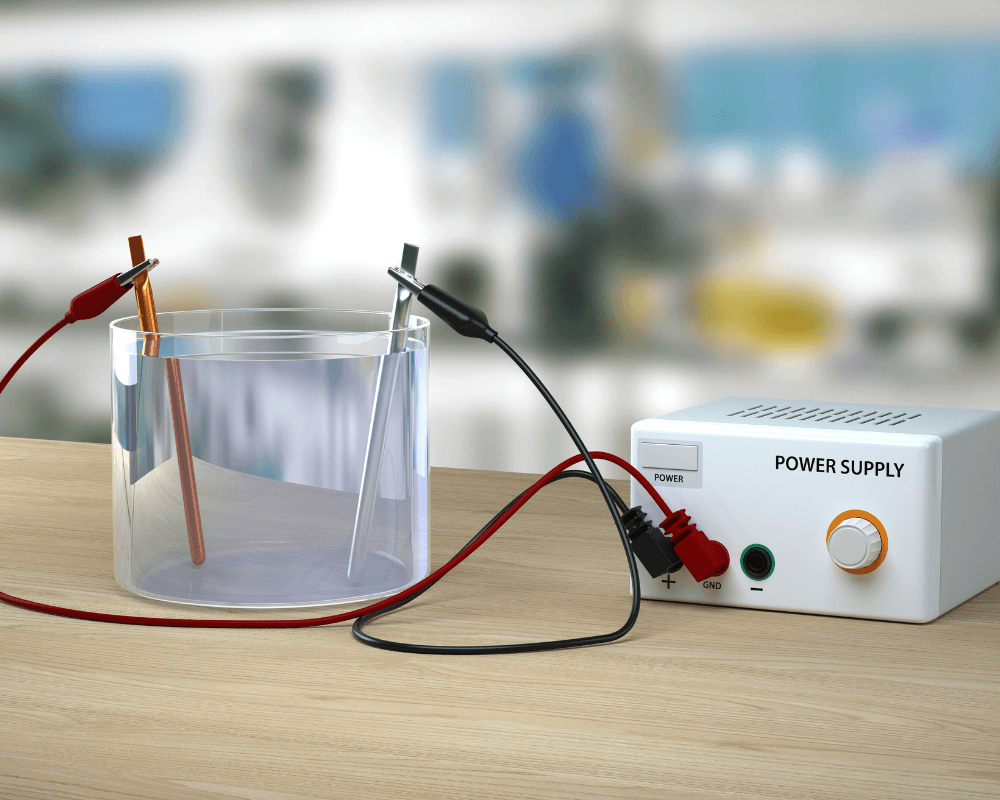
Homemade Water Electrolyzers
Water electrolyzers utilize power (electricity) to separate water into Hydrogen Gas (H2) and Oxygen (O2)[6][7]. Basic water electrolyzers will contain a power supply, a water reservoir, and an electrolytic cell which consists of a pair of electrodes (positive and negative terminal) so electricity can flow. There are two basic types, oxyhydrogen cells that use an electrolyte (e.g. NaOH or KOH) for conductivity and will produce two-part hydrogen gas (66%) one part oxygen (33%), or pure hydrogen cells which, use PEM/SPE (proton exchange membrane/solid polymer electrolyte) for conductivity to produce pure (>99%) hydrogen gas [8]. These electrolytic cell types are utilized widely in the therapeutic hydrogen industry in hydrogen water systems and H2 inhalation units. You can learn more about this topic on our method page.
To many, this project seems to be a conceivable option for how to make hydrogen water at home. Nonetheless, that notion could not be farther from the truth. First, above every other point I mention, safety is the first. Hydrogen gas is a highly flammable gas and three times more energy-dense than gasoline [9][10]. These types of electrolyzers can produce large volumes of hydrogen gas and oxygen which can be very dangerous, especially if not handled properly. There is a high potential to be harmful or induce an injury due to negligence or ignorance. Secondly, it’s my position that the everyday consumer should not be trying to build one of these electrolyzers without the benefit of engineering expertise or engineering background. These systems require several electrical components and the requirement of creating an electrolyte solution, which can be hazardous apart from manufacturer-recommended quantities of water and electrolyte. Once you get past these concerns there is still the cost, inconvenience, and maintenance to deal with, let alone filtering the production gas. Most importantly, if a person does manage to produce a homemade water electrolyzer there is still the challenge of infusing or dissolving the hydrogen gas into water. This is very important as the biomedical research is suggesting 1~3 mg/day of H2 via water appears to be therapeutic for humans. You will need to dissolve at least 0.5 mg/L (ppm) into the water and consume 2~3 liters of water /day to receive the suggested therapeutic dose based on human studies. This method is a whole lot of work that may yield limited results.
The cheapest versions of these devices will be oxyhydrogen systems (66% H2 /33% O2) as they do not require a membrane to perform water electrolysis. However, bubbling (or dissolving) oxyhydrogen into water will at best result in a dissolved hydrogen concentration of 1.03 mg/L (ppm). This is because infusing water with oxyhydrogen (66% H2 /33% O2) will dissolve both gasses up to their partial pressure/saturation point in relation to the gas concentrations being supplied. This means for hydrogen gas saturation will be 1.03 mg/L (ppm) and for O2 saturation will be 13.72 mg/L (ppm) because oxyhydrogen supplies 66% H2 and 33% O2. Henry’s Gas law saturation levels are based on 100% concentration of each gas. Homemade oxyhydrogen electrolyzers will basically produce at best 1.0 mg/L (ppm) H2 water after the water has been sufficiently bubbled. This is a reasonable dissolved hydrogen concentration, however, not for the work required to achieve it.
I understand the primary reason people pursue this option is financial, but I feel it’s my moral obligation to help ensure the safety of those who are seeking to engage in hydrogen therapy or seeking my advice. H2HUBB does not recommend this approach to produce hydrogen water and would especially advise contacting us to discuss pursuing other options.
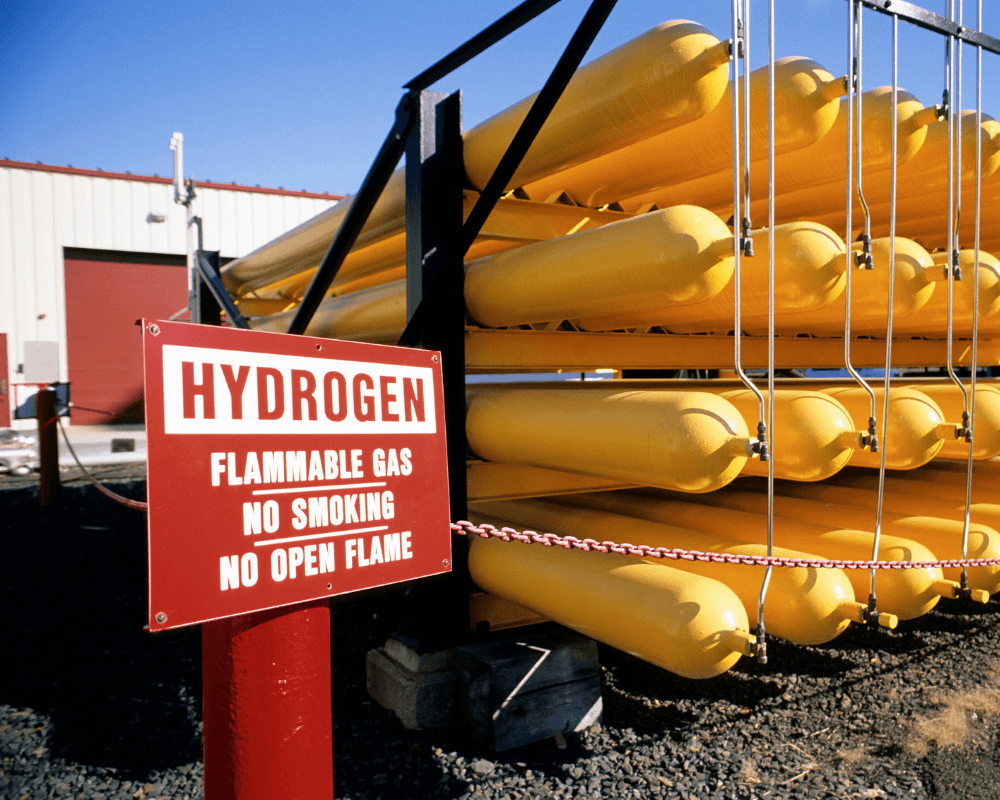
Hydrogen Gas Tanks
This option is the least familiar of the three and likely the least pursued. Also, this option can be expensive which negates the purpose of trying to find a cheap alternative to flag-ship hydrogen water systems on the market. Hydrogen tanks come in various sizes, gas purity, volume amounts (total liters), and price ranges. They are generally used for welding or within a laboratory setting. In recent years, it has become apparent that quite a few people have become interested in purchasing these tanks to make hydrogen water at home. This approach has its limitations as well. Safety is a huge issue as many of these tanks or cylinders contain large volumes of pressurized hydrogen gas. This can lead to a major explosion in a person’s home and can even lead to death. Another point worth mentioning is the purity of the hydrogen gas within the tank. If the tank is an industrial gas tank then the hydrogen gas may contain impurities thus creating water that is improper for ingestion. Furthermore, these tanks have a limited supply of hydrogen gas in liters. They can range from 10~1000+ liters and their price tag can be anywhere from a hundred dollars to thousands depending on size, type, and gas purity. This means they may not last that long.
To illustrate this point, let’s say the tank is about 5 feet tall, 120 cubic ft, and holds 3400 liters of hydrogen gas. This tank could release hydrogen gas for 375 hours for bubbling hydrogen gas into water if the flow rate was at 150 mL/min. 375 hours is equivalent to 15 days or basically for two weeks. Now, no one is gonna release the gas constantly all day but let’s say it takes you an hour/day to bubble your hydrogen water for you and your family. That means this tank would last you a little over a year. That is not a long time especially considering a hydrogen tank of this size could be a considerable amount of money.
With all that in mind, this option seems to lack some practicalities and safety to produce hydrogen water for a limited time at an H2 concentration comparable to the average hydrogen water system on the market (0.5~1.6 mg/L (ppm)).
Now that we have established that the options mentioned in this article are not the best choices for how to make hydrogen water at home, the real question is “How do you make safe hydrogen water at home with therapeutic concentrations?” or “What are the real cost-effective alternatives for making hydrogen water at home?” We have another article that touches on what many people really want and are looking for, which is the “good enough” approach. In essence, hydrogen water products that are cheap but “good enough” for me to potentially reap the benefits of hydrogen therapy (hydrogen water, H2 inhalation, etc). We touch heavily on this topic and strongly feel it’s a valid approach that should be pursued by many. We actually created a term for such products, “entry-level” hydrogen products, hydrogen products in the low-end price range but can get the job done.
Therefore, I will highlight two viable options that I believe are cost-effective (especially in the short term), have exceptional therapeutic value in terms of the research, and lastly will best serve the consumers who are either unable or do not want to invest a large upfront cost to purchase a high-end hydrogen water system.
The Alternatives
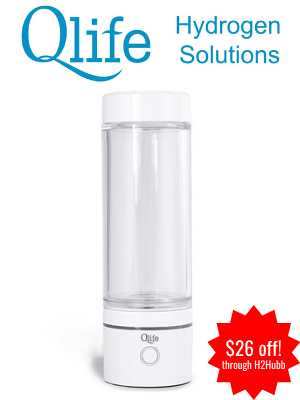
QLife QCup Max: High mg/L (ppm) Hydrogen water bottle
- Cost: $233.10 USD
- Life Span (approx.): 1-2 years
- Cost per liter consumed: 32-64¢
- Cost per milligram of H2 ingested: 6.4-13¢
- 2.0~5.0 mg of H2 per 2-4 bottle/day
- Level 3 Performance Ranking
- This rank is awarded to those products that have achieved 4.0 – 5.9 mg of dissolved hydrogen in 1 liter of water.
The QCup Max is a high mg/L (ppm) hydrogen water product. The product comes with a 240 mL (8.5 oz) high PSI water bottle. The product is super easy to use. First, you will fill the bottle with your preferred drinking water to the threads of the bottle, then screw on the lid. After that, you simply press the activation button, which will start a five-minute cycle. Then without opening the bottle, you run another 5 min cycle. Once the 10 minutes are up, open the bottle and drink up! It’s that easy! The great part about this is that within 10 mins, the bottle will dissolve more than 1 mg of H2 in its designated volume size of 240 mL. That means that simply by drinking 1-4 bottles per day, a person can easily ingest 1-4 mg of H2 per day. This is important because clinical studies administer 1-15 mg of H2 per day.
H2HUBB QCup Max Test Video
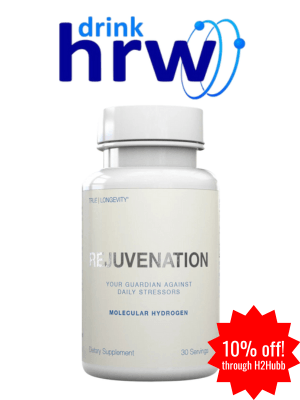
DrinkHRW Rejuvenation: High mg/L (ppm) effervescent hydrogen-producing tablets.
- 60 ct: 44.99/month
- Or 75¢ per tablet/day
- 3.0~5.0 mg of H2 per tablet/day
- Level 4 Performance Ranking
- This rank is awarded to those products that have achieved 6.0 – 10.0 mg of dissolved hydrogen in 1 liter of water.
DrinkHRW Rejuvenation tablets are magnesium-based hydrogen-producing tablets. They will produce high mg/L (ppm) hydrogen water with both dissolved and quasi-dissolved hydrogen gas (suspended gas cloud within the water). These tablets contain 80 mg of magnesium not only making them a great hydrogen product but also a great magnesium supplement, which most Americans are deficient in [11]. The tablets are super easy to use. First, you fill your glass with your preferable drinking water to 500 mL (16 oz) and then drop in a hydrogen tablet. The tablet will react in the water for 2 mins forming hydrogen gas, producing hydrogen water. Once the tablet is done reacting then you drink the water. That’s it! Super easy, super convenient! The hydrogen water these tablets produce will provide approx. 3 mg of H2 or more within each glass, meaning their therapeutic value is exceptionally high. DrinkHRW, same as Aqeula 8.0, has gone to great lengths to demonstrate its product is safe for human consumption. In fact, DrinkHRW Rejuvenation is the only hydrogen supplement in the US that is compliant with FDA regulations as an approved new dietary supplement [12][13]. Also, DrinkHRW Rejuvenation is IHSA (International Hydrogen Standards Association) certified, which also requires an EPA water quality report [14]. Through these accomplishments, DrinkHRW’s Rejuvenation has been demonstrated to be safe for human consumption. Last, but not least, these tablets have been used in several human clinical studies objectively demonstrating their product may have therapeutic potential for humans.
DrinkHRW Human Studies
Here are a few of DrinkHRW’s human studies
- The Effects of 24-Week, High-Concentration Hydrogen-Rich Water on Body Composition, Blood Lipid Profiles and Inflammation Biomarkers in Men and Women with Metabolic Syndrome: A Randomized Controlled Trial
- Acute Supplementation with Molecular Hydrogen Benefits Submaximal Exercise Indices. Randomized, Double-Blinded, Placebo-Controlled Crossover Pilot Study
- Case Report: Acute hydrotherapy with super-saturated hydrogen-rich water for ankle sprain in a professional athlete
Closing Thoughts
Both of these two options are great, cost-effective, entry-level hydrogen products. If you’re an individual looking to try hydrogen therapy but don’t want to spend a ton of money, you cannot go wrong with these two products. Now, the long-term cost of these products is not the best, however, the total upfront cost over the course of a few months is exceptional and can provide over 450 mg of H2 in 90 days, which is insanely rare for the market. So this is my suggestion on how you make water at home safely with therapeutic levels.
Contact us if you have any other questions.
